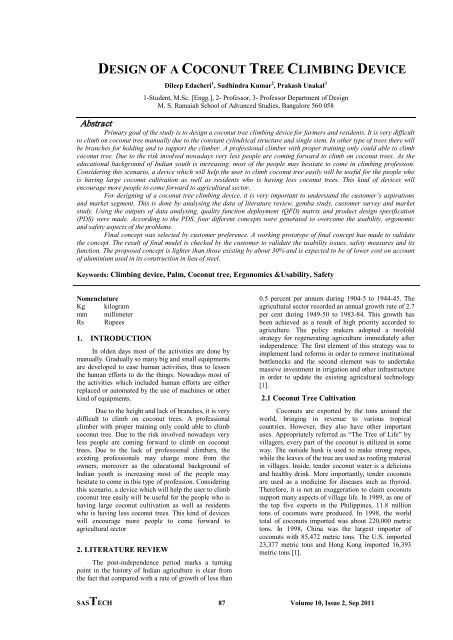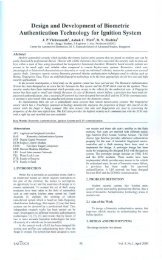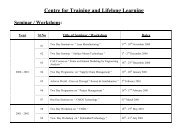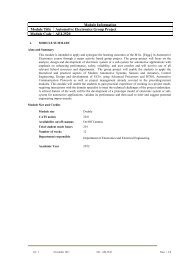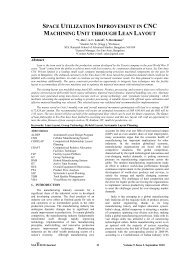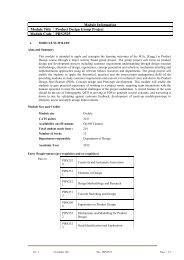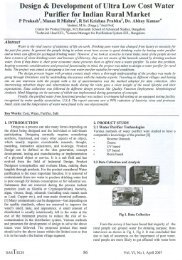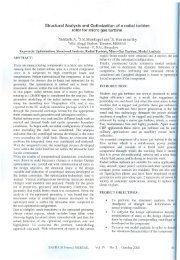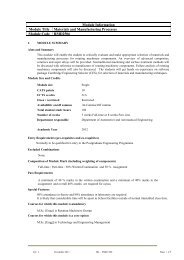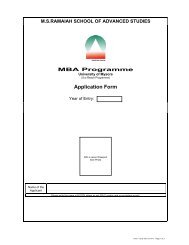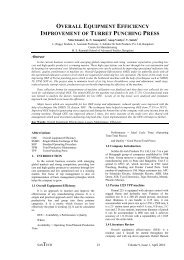SASTech Journal Cover Page Sep2011 A3.cdr - MS Ramaiah ...
SASTech Journal Cover Page Sep2011 A3.cdr - MS Ramaiah ...
SASTech Journal Cover Page Sep2011 A3.cdr - MS Ramaiah ...
Create successful ePaper yourself
Turn your PDF publications into a flip-book with our unique Google optimized e-Paper software.
DESIGN OF A COCONUT TREE CLIMBING DEVICE<br />
Dileep Edacheri 1 , Sudhindra Kumar 2 , Prakash Unakal 3<br />
1-Student, M.Sc. [Engg.], 2- Professor, 3- Professor Department of Design<br />
M. S. <strong>Ramaiah</strong> School of Advanced Studies, Bangalore 560 058<br />
Abstract<br />
Primary goal of the study is to design a coconut tree climbing device for farmers and residents. It is very difficult<br />
to climb on coconut tree manually due to the constant cylindrical structure and single stem. In other type of trees there will<br />
be branches for holding and to support the climber. A professional climber with proper training only could able to climb<br />
coconut tree. Due to the risk involved nowadays very less people are coming forward to climb on coconut trees. As the<br />
educational background of Indian youth is increasing, most of the people may hesitate to come in climbing profession.<br />
Considering this scenario, a device which will help the user to climb coconut tree easily will be useful for the people who<br />
is having large coconut cultivation as well as residents who is having less coconut trees. This kind of devices will<br />
encourage more people to come forward to agricultural sector.<br />
For designing of a coconut tree climbing device, it is very important to understand the customer’s aspirations<br />
and market segment. This is done by analysing the data of literature review, gemba study, customer survey and market<br />
study. Using the outputs of data analysing, quality function deployment (QFD) matrix and product design specification<br />
(PDS) were made. According to the PDS, four different concepts were generated to overcome the usability, ergonomic<br />
and safety aspects of the problems.<br />
Final concept was selected by customer preference. A working prototype of final concept has made to validate<br />
the concept. The result of final model is checked by the customer to validate the usability issues, safety measures and its<br />
function. The proposed concept is lighter than those existing by about 30% and is expected to be of lower cost on account<br />
of aluminium used in its construction in lieu of steel.<br />
Keywords: Climbing device, Palm, Coconut tree, Ergonomics &Usability, Safety<br />
Nomenclature<br />
Kg kilogram<br />
mm millimeter<br />
Rs Rupees<br />
1. INTRODUCTION<br />
In olden days most of the activities are done by<br />
manually. Gradually so many big and small equipments<br />
are developed to ease human activities, thus to lessen<br />
the human efforts to do the things. Nowadays most of<br />
the activities which included human efforts are either<br />
replaced or automated by the use of machines or other<br />
kind of equipments.<br />
Due to the height and lack of branches, it is very<br />
difficult to climb on coconut trees. A professional<br />
climber with proper training only could able to climb<br />
coconut tree. Due to the risk involved nowadays very<br />
less people are coming forward to climb on coconut<br />
trees. Due to the lack of professional climbers, the<br />
existing professionals may charge more from the<br />
owners, moreover as the educational background of<br />
Indian youth is increasing most of the people may<br />
hesitate to come in this type of profession. Considering<br />
this scenario, a device which will help the user to climb<br />
coconut tree easily will be useful for the people who is<br />
having large coconut cultivation as well as residents<br />
who is having less coconut trees. This kind of devices<br />
will encourage more people to come forward to<br />
agricultural sector<br />
2. LITERATURE REVIEW<br />
The post-independence period marks a turning<br />
point in the history of Indian agriculture is clear from<br />
the fact that compared with a rate of growth of less than<br />
0.5 percent per annum during 1904-5 to 1944-45. The<br />
agricultural sector recorded an annual growth rate of 2.7<br />
per cent during 1949-50 to 1983-84. This growth has<br />
been achieved as a result of high priority accorded to<br />
agriculture. The policy makers adopted a twofold<br />
strategy for regenerating agriculture immediately after<br />
independence. The first element of this strategy was to<br />
implement land reforms in order to remove institutional<br />
bottlenecks and the second element was to undertake<br />
massive investment in irrigation and other infrastructure<br />
in order to update the existing agricultural technology<br />
[1].<br />
2.1 Coconut Tree Cultivation<br />
Coconuts are exported by the tons around the<br />
world, bringing in revenue to various tropical<br />
countries. However, they also have other important<br />
uses. Appropriately referred as “The Tree of Life” by<br />
villagers, every part of the coconut is utilized in some<br />
way. The outside husk is used to make strong ropes,<br />
while the leaves of the tree are used as roofing material<br />
in villages. Inside, tender coconut water is a delicious<br />
and healthy drink. More importantly, tender coconuts<br />
are used as a medicine for diseases such as thyroid.<br />
Therefore, it is not an exaggeration to claim coconuts<br />
support many aspects of village life. In 1989, as one of<br />
the top five exports in the Philippines, 11.8 million<br />
tons of coconuts were produced. In 1998, the world<br />
total of coconuts imported was about 220,000 metric<br />
tons. In 1998, China was the largest importer of<br />
coconuts with 85,472 metric tons. The U.S. imported<br />
23,377 metric tons and Hong Kong imported 16,393<br />
metric tons [1].<br />
SASTECH 87 Volume 10, Issue 2, Sep 2011
2.2 Coconut Tree Climbing Without Any<br />
Device<br />
It’s very hard to learn the necessary skills to<br />
climb coconut trees. The few first times, peoples<br />
barely managed to get a few feet off the ground. In<br />
addition to fear, the soft skin on the palms of hands<br />
and soles of feet made climbing difficult. During the<br />
initial climbing the skin of palm, chest and foot skin<br />
may be disturbed. This is what happens when people<br />
slide down hugging a coconut tree as hard as they can.<br />
There are two basic techniques and they are easy to<br />
learn. After that the user just need to practice and to<br />
forget about soft skin. It will probably get cut a bit the<br />
first time on the tree, but after continuous practice it<br />
will be fine. After a week, climbing the trees becomes<br />
second nature and the collection of coconuts is one of<br />
the easier and more enjoyable survival skills the user<br />
will learn. All techniques should be done barefoot and<br />
barehanded. A long sleeve T-shirt might save the<br />
user’s skin from abrasion against the tree especially<br />
when the people are learning [2].<br />
The first method is the front-foot technique. It is<br />
similar to rock climbing. The rock climber stuff their<br />
hands inside cracks, pull on them and push on the legs<br />
in opposition and walk up the rock. This front foot<br />
technique to climb coconut tree is very similar. The<br />
climbing person has to put his hands close to each<br />
other on the back of the trunk, and pull one foot in<br />
front of the other one in front of the climbing person<br />
on the tree. By keeping pressure on the trunk with the<br />
balls of the climbing person’s feet and toes, walk up<br />
alternating moving feet and hands. Technically it<br />
seems to be the easiest to learn but requires good<br />
balance and arm strength [2].<br />
Fig. 1 The front foot technique<br />
3. DATA COLLECTION<br />
3.1 Product Context Study<br />
Coconut tree climbing equipment helps to climb<br />
on coconut tree without much human efforts. At<br />
present there are mainly two types of coconut tree<br />
climbing devices are available in Indian market. These<br />
devices can be operated by the effort of one person.<br />
The age limit of the user can be approximately 17<br />
years to 60 years. The two types are:<br />
1) Sitting type climbing device<br />
2) Standing type climbing device<br />
i. Sitting Type Climbing Device<br />
Sitting type coconut climbing device is<br />
developed by Tamil Nadu Agricultural University<br />
(TNAU). The device has two <strong>MS</strong> frames; one upper<br />
and lower; they are connected by a belt while the<br />
equipment is on the coconut tree. The user has to sit on<br />
the seat which is provided on upper frame and has to<br />
insert his foot between the rubber rollers available in<br />
the lower frame. The upper frame can be lift by hands<br />
and the lower frame has to be lifted by leg. The<br />
process has to be repeated for the continuous climbing.<br />
In this type, the size can be adjusted as per the coconut<br />
tree diameter. This can be done by adjusting the <strong>MS</strong><br />
steel bar using the plastic knobs. As both frames are<br />
positioned in angle, due to the friction by rubber bush<br />
it will get cling to the tree and the process has to repeat<br />
for further climbing. Safety belt can be adjusted for<br />
proper body posture. Distance between the top and<br />
bottom frames can be adjusted by the belt as per the<br />
convenience. It will be give more support to the user as<br />
there is a provision for sitting. It will help small<br />
farmers as well as people who own 15 to 20 coconut<br />
trees in the backyard of their houses. Even unskilled<br />
person can climb on coconut tree by using this device.<br />
The weight of the device is approximately 9 Kg.<br />
Fig. 2 Sitting type climbing device<br />
ii. Standing Type Climbing Device<br />
Fig. 2 shows typical constructional details of<br />
standing type tree climbing equipment. Mr. M J<br />
Joseph, an agriculturist in Kerala is the person to bring<br />
out the initial concept of this type of coconut tree<br />
climbing device.<br />
It has got mainly two assemblies of similar<br />
construction. The user has to co-ordinate these two<br />
assemblies simultaneously by using hands and legs to<br />
climb on coconut tree. In this construction, the user has<br />
to stand and operate the device. Initially the steel rope<br />
wires of both top and bottom assembly has to be<br />
looped with the tree and has to be locked. Then the<br />
user can stand by placing foot on both assemblies and<br />
has to hold on the handles provided. As the user lift the<br />
assembly by foot and raise the either assembly by hand<br />
the steel rope will get loosen and when he push back<br />
with foot after reaching to a particular height it will get<br />
tighten. By this process the user can climb to the tree<br />
easily.<br />
SASTECH 88 Volume 10, Issue 2, Sep 2011
To go down the user has to loosen the loop by<br />
raising his leg and pulling the handle, then he has to<br />
move down the device to a particular distance. From<br />
there the loop has to be tightened by pushing the leg<br />
towards down. For easy climbing, the body posture has<br />
to be kept straight<br />
In this type of construction the steel rope wire<br />
will get adjusted as per the diameter of the tree by the<br />
force applied by the user towards gravity. Here the<br />
device has to be operated by standing and there is no<br />
support for the body while climbing. This may cause<br />
fatigue to the climbing person during initial climbing.<br />
The weight of the device is approximately 7 Kg. The<br />
user can climb 40m in 2-3 minutes.<br />
Fig. 3 Standing type climbing device<br />
3.2 Market Study<br />
Market study is essential before introducing new<br />
product in market. For the success of the new product,<br />
current market trends have to analyse deeply. All<br />
variety of a particular product has to be considered to<br />
understand their movements in the market. The cost of<br />
each product has to be studied to understand at what<br />
extend customer are accepting that product.<br />
According to the retailer voice standing type<br />
climbing devices are most selling product. As a rough<br />
estimation 10 pieces per month are selling out. Sitting<br />
type climbers are selling in the range of 6-7 pieces per<br />
month. Market prices are below shown.<br />
Sitting type: Rs 2500<br />
Standing type: Rs 1300<br />
Sitting type tree climbing devices are<br />
manufactured by St. Mary’s industries, Kerala and<br />
standing type devices are manufactured by Tamilnadu<br />
Agricultural University (TNAU), Coimbatore. Both<br />
type devices are export to foreign countries as per the<br />
requirement.<br />
3.3 Gemba Study & Customer Survey<br />
Study and understand of user environment is<br />
essential for the development of new product. Gemba<br />
study will provide answers to many important questions<br />
like, how they use the product, what are the issues they<br />
face and how the product can be improved etc.<br />
User survey is conducted among the professional<br />
climbers as well as those who are climbing only for<br />
residential purpose. Video survey is done to understand<br />
and analysis the actual climbing process. Study is<br />
conducted on professional climbers for analyzing how<br />
they are interacting with this. Study separately<br />
conducted on the people where they are not using any<br />
kind of devices for coconut tree climbing, but they use<br />
only rope loops for climbing .Customer survey is done<br />
and filled questionnaire to understand their requirements<br />
Fig. 4 Gemba study<br />
3.4 User Study on Sitting Type<br />
In sitting type of coconut tree climbing device,<br />
initial stages people used to get back pain. As the leg<br />
has to be inserting between rollers, due to rubbing,<br />
people used to get pain. Initial training is essential for<br />
the climbing. The user has to balance between the top<br />
and bottom halves, or else the device may stuck while<br />
climbing. There are no accidents reported by using this<br />
device. The main structure is made up of iron and can<br />
be rust by long use. Most of the time the climbing<br />
device during rainy season also, this may lead to<br />
corrosion of the main frames<br />
3.5 User Study on Standing Type<br />
This device is mainly used by coconut farmers<br />
and residents in Kerala. The construction of this device<br />
is simple and easy to operate by common people. The<br />
user has to stand and coordinate with the two halves of<br />
the device for climbing.<br />
The main observation indicates that the user get<br />
tired soon as he is operating this device by continuous<br />
standing during initial climbing. The main advantage<br />
of standing type climbing device from sitting type is<br />
the less weight; this enables women also to climb the<br />
coconut tree easily.<br />
The main problem raised by the people they<br />
use the device continuously is the breakage of steel<br />
rope wire after 3-4 month of usage.<br />
3.6 Summary of Gemba Study<br />
• There are many methods to climb coconut tree<br />
without any devices.<br />
• Professional climbers use rope loop for climbing<br />
and they are comfortable with it.<br />
• Still so many researches are going on this field for<br />
improved product.<br />
• Sitting type coconut tree climbing device is looking<br />
good, but it has more weight compare to standing<br />
type.<br />
• As there is a provision for sitting in sitting type<br />
climbing device, it will not create much body ache<br />
• In sitting type device the user has to lift the device<br />
by using hands and legs. As weight is more for<br />
sitting type device, it gives more tiredness compare<br />
to standing type<br />
• Speed of climbing is more for standing type due to<br />
less weight<br />
SASTECH 89 Volume 10, Issue 2, Sep 2011
• In sitting type the size has to be adjusted as per the<br />
diameter of the coconut tree, but in standing type it<br />
is self adjusted.<br />
• Speed depends on the effort of climbing person<br />
• Standing type is simple in construction and easy to<br />
use compare to sitting type.<br />
• In sitting type device may stuck while climbing on<br />
the tree. Standing type doesn’t create this problem<br />
• The iron rope wire gets disconnected from the lock<br />
area at some time, but the frequency of this is very<br />
less. It may happen once after 100 climbing<br />
• In sitting type device, the user need not change any<br />
parts, but in standing type device the user has to<br />
change the steel rope wire as it will damage due to<br />
continuous use.<br />
4. PROBLEM STATEMENT<br />
The user’s need and present status of the product<br />
is studied by the customer survey and GEMBA study.<br />
The designer should have to define the problem with<br />
these customer requirements to develop a new product<br />
which will satisfy the end user. Problem statement of<br />
this study is to design and develop the coconut tree<br />
climbing device for improved ergonomics and safety.<br />
4.1 Methodology<br />
• Literature review was carried out from journals,<br />
books, manuals and related documents<br />
• Research to understand target user’s (farmers and<br />
residents) need was conducted<br />
– Literature survey<br />
• Technical specification, product context<br />
study, Market study and user study<br />
– Ethnography study<br />
– Interviews with focus groups<br />
– Data collection in the form of visuals, text,<br />
videos etc.<br />
• QFD was generated based on the customer<br />
requirements and PDS generated by prioritizing the<br />
features in the QFD<br />
• Concepts were generated through sketches and<br />
software's by using<br />
– Morphological analysis, Triz, 6-3-5 Method<br />
– Lifestyle board, Mood boards, Theme boards<br />
• Five concepts were generated by using Pro-Engineer<br />
• Concept evaluation for selecting the final concept<br />
was carried out by weighted ranking method<br />
• Final digital model was created with detailed<br />
features and mechanisms by using Pro Engineer<br />
• A coconut tree climbing device prototype was made.<br />
• A questionnaire was created, focus groups invited<br />
and feedback collected from the targeted users and<br />
conclusions drawn<br />
4.2 Quality Function Deployment<br />
QFD is an objective method for ensuring<br />
quality from the earliest stages of product development.<br />
The aim is to create a product that will fully satisfy<br />
users by incorporating their requirements to design.<br />
Before preparing QFD, the user voice has been refined<br />
in to technical voice. The results from QFD matrixes<br />
were analyzed. The highest rated Technical<br />
characteristics have been taken for the design process.<br />
From the QFD matrixes, ergonomics and<br />
usability fetch more point as coconut tree climbing<br />
device has to be operated by continuous human power<br />
ergonomic and usability factor has much importance in<br />
it. In present coconut tree climbing device there is some<br />
ergonomic and usability issues were found. Mechanism<br />
has got second highest points in QFD matrixes.<br />
Multiple features and material also important for<br />
coconut tree climbing device<br />
Table 24 QFD<br />
Technical Characteristics Importance<br />
Rating<br />
Material 61<br />
Mechanism 81<br />
Multiple features 67<br />
Shape and color 19<br />
Ergonomics and usability 91<br />
4.3 Product Design Specification (PDS)<br />
The product design specification is a set of<br />
defined information that helps to meet the design<br />
considerations & the requirements. It gives the details<br />
all the considerations from design to manufacturing. In<br />
the PDS all the specified data has to be defined<br />
properly. The proper flow of process will be gained to<br />
achieve the concepts with this information. The final<br />
Product Design Specification (PDS) is shown in table<br />
4.2.<br />
Table 25 PDS<br />
Target users<br />
Farmers, residents and professional tree<br />
climbers<br />
Agricultural and coconut development<br />
Target customer boards, farmers, residents and<br />
professional tree climbers<br />
Size Max. Height : 105cm<br />
Max. Length : 27cm<br />
Max. Width : 27cm<br />
Weight 5 Kg - 9 kg<br />
Cost<br />
Type of tree<br />
Rs. 1400 -Rs. 1900<br />
climbing device Standing type<br />
Materials Mild Steel<br />
Steel rope wire<br />
Rubber pad<br />
Safety<br />
Appearance/<br />
No sharp corners, grip and smooth<br />
material for handles, safety belt<br />
colour Green/red<br />
Features<br />
Less weight, simple mechanism,<br />
ergonomic and improved safety<br />
Performance Continuous<br />
Environment Exposure to moisture will cause rusting<br />
Approximately 150000 trees can be<br />
Product life span<br />
climbed during product life<br />
Maintenance Periodic maintenance after 100 trees<br />
Packaging <strong>Cover</strong> with polythene sheet<br />
Manufacture<br />
Batch production or as and when<br />
customer required<br />
SASTECH 90 Volume 10, Issue 2, Sep 2011
5. CONCEPT GENERATION<br />
The concepts are generated from the data<br />
obtained from QFD and PDS. As per PDS, all the<br />
engineering parts were finalized, and then the external<br />
shapes and mechanism has been derived. The concept<br />
includes the ergonomic considerations, aesthetics and<br />
the external shape of the product. The basic<br />
specification has been already generated in PDS. These<br />
requirements, specifications or technical characteristics<br />
are then used as the base for developing various<br />
concepts. Mind mapping tool used to explore idea<br />
generation and then visual theme board is prepared for<br />
understanding the similar kind of devices using in<br />
cultivation.<br />
5.1 Mind Mapping<br />
Concept generation process has initiated with the<br />
help of idea generation tool “mind mapping”. The idea<br />
developed by this method is depends up on their own<br />
thinking and knowledge level. Here entire parameter is<br />
arranged in common keywords and add link on each<br />
item so that many ideas can build up each parameter.<br />
Fig. 5 Mind mapping<br />
As a result of mind mapping, the idea of<br />
changing existing material to reduce weight, providing<br />
comfortable handle etc. have come out. On the basis of<br />
these outcome five concepts were generated<br />
5.2 Visual Theme Board<br />
Fig. 6 Visual theme board<br />
Most of the farming equipments are made up of<br />
metals and are less aesthetic. The important factors to be<br />
considered are ergonomics ease of use and safety.<br />
5.3 Concept<br />
Fig. 7 Concept-1<br />
This concept shown in fig.7 is a basic alteration of<br />
sitting type tree climbing device. In this sitting type has<br />
changed to standing type. It will reduce the weight of<br />
the equipment as the extra frame for sitting is<br />
eliminated. The adjustable safety belt will support the<br />
user and will reduce the back pain while climbing.<br />
5.4 Concept-2<br />
Fig. 8 Concept-1 detailing<br />
Fig. 9 Concept-2<br />
This concept shown in fig.9 is a basic alteration of<br />
sitting type tree climbing device. The main difference<br />
from the concept 1 is that here the steel rope wire has<br />
accommodated in the top assembly. The main advantage<br />
is that it will reduce the weight and the size adjustment<br />
is by utilising the rings at the end of the steel rope wire.<br />
SASTECH 91 Volume 10, Issue 2, Sep 2011
In this construction, the user has to stand and operate<br />
the device.<br />
5.5 Concept-3<br />
Fig. 10 Concept-2 detailing<br />
Fig. 11 Concept-3<br />
In this construction, the user has to stand and<br />
operate the device. Initially the steel rope wires of both<br />
top and bottom assembly has to be looped with the tree<br />
and has to be locked. Then the user can stand by placing<br />
foot on both assemblies. As the user lift the assembly by<br />
foot the steel rope will get loosen and when he push<br />
back with foot it will get tighten. By this process the<br />
user can climb to the tree easily.<br />
To go down the user has to loosen the loop by<br />
raising his leg and pulling the handle, then he has to<br />
move down the device to a particular distance. From<br />
there the loop has to be tightened by pushing the leg<br />
towards down. For easy climbing, the body posture has<br />
to be kept straight. In cocept-3 both the half is spited<br />
into two. This will help the user to transport the devise<br />
easily from one place to other.<br />
Fig. 12 Concept-3 detailing<br />
5.6 Concept-4<br />
Fig. 13 Concept-4<br />
This concept shown in fig.13 is a basic<br />
alteration of sitting type tree climbing device. In this<br />
construction, the user has to stand and operate the<br />
device. The foot has to insert between the bottom rubber<br />
roller and flat foot rest and the top frame has to move up<br />
by using the handle provided. As both frames are<br />
positioned in angle, due to the friction by rubber bush it<br />
will get cling to the tree and the process has to repeat for<br />
further climbing. Safety belt can be adjusted for proper<br />
body posture. Distance between the top and bottom<br />
frames can be adjusted by the belt as per the<br />
convenience. The plastic knob can be used to adjust the<br />
size of the top and bottom frame.<br />
5.7 Concept-5<br />
In this construction in fig. 14, the user has to<br />
stand and operate the device. Initially the steel rope<br />
wires of both top and bottom assembly has to be looped<br />
with the tree and has to be locked. Then the user can<br />
stand by placing foot on both assemblies. As the user<br />
lift the assembly by foot the steel rope will get loosen<br />
and when he push back with foot it will get tighten. By<br />
this process the user can climb to the tree easily.<br />
Fig. 14 Concept-5<br />
SASTECH 92 Volume 10, Issue 2, Sep 2011
Fig. 15 Concept-5 detailing<br />
.<br />
5.8 Concept Selection<br />
Selecting final concept is very important task in a<br />
product design cycle, in which each and every feature<br />
has to be cross checked in details. We can do concept<br />
selection by so many methods. Here concept selection<br />
has been done by Dot-matrixes method and through<br />
customer preference.<br />
i. Dot-matrixes method<br />
Fig. 16 Concept selections<br />
In Dot-matrixes method concept 5 has got maximum<br />
point.<br />
ii. Customer Feedback<br />
Fig. 17 Concept selections<br />
In Customer feedback most of person selected<br />
concept-5 and concept-2, but in Dot matrixes method<br />
concept-5 got maximum points. So concept-5 was<br />
selected as a final concept.<br />
5.9 Concept Iteration<br />
Fig. 18 Concept iteration<br />
The handle design and locking area design has<br />
modified for better ergonomics and usability.<br />
i. Material Research for the Selected<br />
Concept<br />
In the present design the frames are made up of<br />
mild steel. The weight of the device is 5Kg. If the<br />
weight of the device can be still reduced, it will be very<br />
useful for the user. One method to reduce the weight is<br />
to replace the main frame material from <strong>MS</strong> to any other<br />
material of less density and which should give the same<br />
performance as that of <strong>MS</strong>. As a result of studying the<br />
properties of different grades of Aluminium alloys, it<br />
has understood that Aluminium alloy 7075 can be used<br />
instead of the mild steel frames of the coconut tree<br />
climbing device.<br />
At present Steel wire rope of 19 strands is<br />
using without any core. If it is possible to use higher<br />
grade of steel wire rope, it will eliminate the breakage.<br />
6x19 FC RH OL FSWR will be a suitable steel rope<br />
wire which can be used on the final concept tree<br />
climbing device for long use without breakage.<br />
6. WORKING MODEL<br />
Working model of final concept has made. Major<br />
sequences of operation included in working model<br />
development are left and right frame construction,<br />
welding, painting and assembly. Major processes<br />
involved are bending, drilling and welding.<br />
SASTECH 93 Volume 10, Issue 2, Sep 2011
7. VALIDATION<br />
Fig. 19 Working model<br />
The working model has assembled and taken into<br />
user’s environment. The validation of the coconut tree<br />
climbing device has done by self and by a residential<br />
user.<br />
Fig. 20 Validation<br />
8. SUMMARY<br />
The study was started to develop a coconut tree<br />
climbing device. Due to the lack of professional<br />
climbers, the existing professionals may charge more<br />
from the owners, moreover as the educational<br />
background of Indian youth is increasing most of the<br />
people may hesitate to come in this type of profession.<br />
Considering this scenario, a device which will help the<br />
user to climb coconut tree easily will be useful for the<br />
people who is having large coconut cultivation as well<br />
as residents who is having less coconut trees. The<br />
existing products, literature survey and user study have<br />
analysed and compiled to generate QFD and PDS.<br />
Concepts were generated and selection of the concept<br />
has done. The selected concept was developed as a 1:1<br />
working model. The working model has then validated<br />
in user’s environment and feed backs are collected. The<br />
proposed working model is lighter than those existing<br />
by about 30% and is expected to be of lower cost on<br />
account of aluminium used in its construction in lieu of<br />
the steel used in other currently available designs.<br />
9. REFERENCES<br />
[1] Don Norman., “The Design of Everyday<br />
Things, Reach and control”, volume 1, 1992.<br />
[2] Jeff Jepson., “The Tree Climber's<br />
Companion”, Beaver Tree Publishing, May<br />
2000.<br />
[3] Debkumar Chakrabarti, “Indian<br />
Anthropometric Dimensions For Ergonomic<br />
Design Practice”, IIT Ahmadabad, volume 1,<br />
1992<br />
[4] Prof. G.S Bhalla., “The Nature of Agricultural<br />
Development in India” http://isid.org.in,<br />
retrieved on 22 nd Oct. 2010.<br />
[5] Melissa Jawaharlal., “Coconut Tree Climbing<br />
Device”, www.nciia.org, retrieved on 22 nd<br />
Oct. 2010.<br />
[6] Unknown, www.caske2000.org, retrieved on<br />
27 th Oct. 2010.<br />
[7] Unknown, www.groups.google.com, retrieved<br />
on 27 th Oct. 2010.<br />
[8] Unknown, www.agritech.tnau.ac.in, retrieved<br />
on 22 nd Oct. 2010.<br />
[9] Unknown, www.nif.org.in, retrieved on 29 th<br />
Oct. 2010.<br />
[10] Unknown, www.hindu.com, retrieved on 29 th<br />
Oct. 2010.<br />
[11] Unknown, www.treebuzz.com, retrieved on<br />
29 th Oct. 2010.<br />
[12] Unknown, www.ciri.org.nz, retrieved on 22 nd<br />
Oct. 2010.<br />
SASTECH 94 Volume 10, Issue 2, Sep 2011


